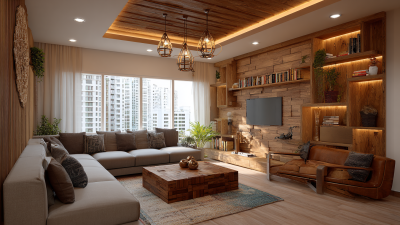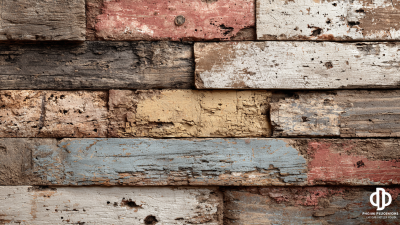Wall siding plays a crucial role in enhancing a home's curb appeal, influencing not only aesthetic value but also energy efficiency and property resale value. According to the Remodeling 2021 Cost vs. Value Report, homeowners can recoup an impressive 63.7% of their investment in new siding upon selling their homes. Furthermore, research from the National Association of Realtors indicates that 90% of homebuyers prioritize exterior aesthetics when selecting a property, underscoring the importance of choosing the right wall siding materials and styles.

With a myriad of options available, from classic wood and vinyl to modern fiber cement and steel, understanding the benefits and visual impact of each type is essential for any homeowner looking to bolster their property's first impression. This guide delves into various wall siding choices and tips, providing insights that can help you make informed decisions while enhancing your home's curb appeal.
 When it comes to enhancing your home's curb appeal, selecting the right wall siding materials is crucial. Among the top options, natural wood siding offers a timeless aesthetic that exudes warmth and charm. Its natural hues can be complemented by the trendy chocolate-brown tones that have recently gained popularity in home exteriors, creating a sophisticated yet inviting look. Additionally, materials like manufactured stone veneers mimic the elegance of traditional stone while being cost-effective and easier to install.
When it comes to enhancing your home's curb appeal, selecting the right wall siding materials is crucial. Among the top options, natural wood siding offers a timeless aesthetic that exudes warmth and charm. Its natural hues can be complemented by the trendy chocolate-brown tones that have recently gained popularity in home exteriors, creating a sophisticated yet inviting look. Additionally, materials like manufactured stone veneers mimic the elegance of traditional stone while being cost-effective and easier to install.
Aside from aesthetics, functionality plays a crucial role in choosing wall siding. Fiber cement siding, known for its resilience and low maintenance, is a favorite among homeowners looking for durability without compromising on style. Furthermore, modern shingle siding can create a chic, layered appearance that enhances visual interest while offering versatility in color and texture options. These materials and styles not only contribute to a striking first impression but can also significantly boost your home's overall value.
When it comes to enhancing curb appeal, choosing the right wall siding is crucial. There are various styles available that cater to different architectural tastes, making it essential to explore popular options. Among these, vinyl siding has surged in popularity, with a 30% market share in the siding industry, according to a recent report by the American Institute of Architects (AIA). This low-maintenance option is available in a wide range of colors and textures, making it perfect for homeowners looking to boost their home’s aesthetic without compromising functionality.
Another standout is fiber-cement siding, which has gained traction due to its durability and fire resistance. Reports highlight that homes with fiber-cement siding can see a return on investment (ROI) of up to 77% upon resale, making it a smart choice for homeowners. For those who appreciate a more traditional look, wood siding remains a classic favorite. Although it requires more maintenance, its natural appeal and warmth can create a stunning exterior.
**Tip:** When selecting siding, consider the local climate and maintenance requirements to ensure long-lasting results. Choosing materials that align with your home's architectural style not only enhances appearance but can also secure increased property value over time. Always consult professional siding contractors for the best advice tailored to your specific needs.

Choosing the right siding color for your home can significantly enhance its curb appeal. To help you make the best choice, here are some crucial tips to consider. First, think about the architectural style of your home. A traditional house may look great with classic shades like beige or gray, while a modern home could benefit from bold colors such as deep blues or bright whites.
Another important factor is the surrounding environment. Consider the colors of your neighborhood, landscaping, and nearby structures. Opting for complementary shades will create a cohesive look. Additionally, pay attention to the homeowners’ association rules if you're in a controlled community. This could influence your choice, ensuring your home remains in harmony with the surrounding properties.
Lastly, test your color choices in different lighting conditions. Colors can seem different depending on the time of day and angle of sunlight. Take samples and observe how they look both in bright sunlight and during the evening hue before making a final decision. These simple tips can help you select siding colors that truly enhance your home's charm and character.
In 2023, wall siding design is witnessing fresh trends that elevate curb appeal while ensuring functionality. One of the most notable trends is the use of sustainable materials. As homeowners increasingly prioritize eco-friendliness, siding options like reclaimed wood, bamboo, and fiber cement are gaining popularity. These materials not only reduce environmental impact but also provide a unique aesthetic that can enhance the overall charm of a home.
Another emerging trend is the combination of textures. Mixing different siding materials, such as combining horizontal wood planks with vertical vinyl panels or stone accents, creates a dynamic visual effect. This approach adds depth to the facade and allows homeowners to express their personal style.
**Tips:** When selecting materials, consider local climate conditions and maintenance needs to ensure durability. Additionally, don’t shy away from experimenting with colors—bold hues can transform a standard design into something striking. Finally, blend modern designs with traditional elements to create a timeless appeal that stands out in your neighborhood.
When considering wall siding materials, maintenance plays a crucial role in preserving aesthetics and extending the lifespan of your home’s exterior. Regular upkeep is essential for longevity. For example, professionals recommend cleaning siding surfaces at least twice a year to prevent dirt, mold, and mildew buildup, especially for materials like vinyl and wood. Inspections for damage or wear can help identify areas that need repair, ensuring your siding remains visually appealing and functional.
In recent years, there's been a significant shift toward sustainable options in wall cladding choices. Notably, thermally modified wood has gained traction, offering a balance between performance and aesthetic appeal. According to market insights, the green building materials sector is expected to rise significantly, with sustainable cladding projected to grow by over 10% annually through the next few years. Homeowners are now prioritizing eco-friendly options while still seeking durability and low maintenance. Additionally, choosing materials that resist fading, like fiber cement or engineered wood, can further reduce the need for frequent upkeep, allowing for a low-maintenance and environmentally responsible home design.
| Siding Material | Style | Durability (Years) | Maintenance Frequency | Aesthetic Appeal |
|---|---|---|---|---|
| Vinyl | Lap | 20-40 | Every 2-3 Years | Good |
| Wood | Shingle | 20-30 | Yearly | High |
| Fiber Cement | Board and Batten | 30-50 | Every 5-10 Years | Excellent |
| Metal | Corrugated | 40-70 | Every 10-15 Years | Good |
| Stucco | Textured | 50+ | Every 5 Years | Variable |






